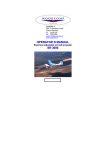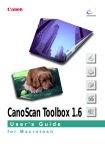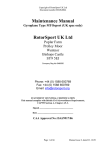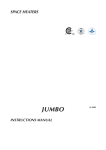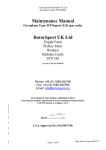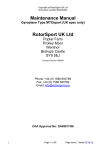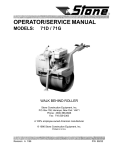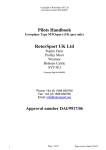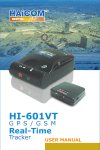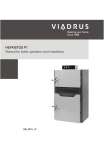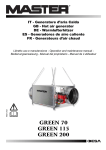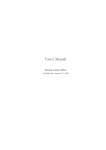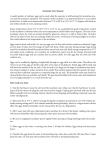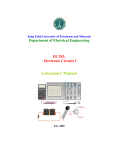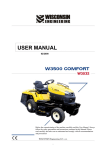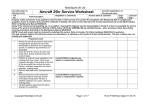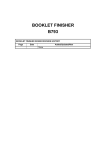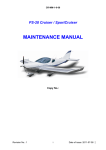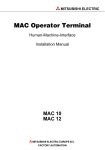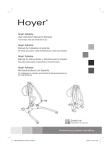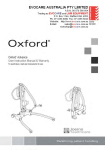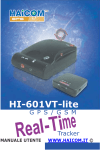Download OPERATOR´S MANUAL SR 3000
Transcript
Vodolská 4 250 70 Odolena Voda Czech Republic Tel.: 283971309 Fax: 283970286 e-mail: [email protected] www.woodcomp.cz O OP PE ER RA ATTO OR R´´S SM MA AN NU UA ALL Electrical adjustable aircraft propeller S SR R 33000000 O OP PE ER RA ATTO OR R´´S SM MA AN NU UA ALL Electrical adjustable aircraft propeller S SR R 33000000 Content: 1. List of valid pages .......................................................... 5 2. List of revised pages ...................................................... 6 3. In general ......................................................................... 7 Propeller purpose ........................................................... 7 3.2. Control regimes ........................................................................ 7 3.2.1. The manual control regime ...................................................................7 3.2.1.1. Propeller control on the instrument panel .............................................7 3.2.1.2. Propeller control on control stick ...........................................................7 3.2.2. The automatic control regime - Constant speed ...................................8 4. Marking ............................................................................ 9 4.1. 4.2. Marking the hub ........................................................................ 9 Marking the blades ................................................................... 9 5. Performance data ......................................................... 10 6. Design, structure and instruction for operation ........ 12 6.1. 6.2. 6.3. Blades .................................................................................... 12 Hub ......................................................................................... 13 Mechanism of adjustment ...................................................... 14 6.3.1. The stops of propeller blade position ..................................................14 6.3.1.1. The main system .................................................................................15 6.3.1.2. The back-up system ............................................................................15 6.4. 6.5. Spinner ................................................................................... 16 Control units ........................................................................... 17 6.5.1. Manual control regime.........................................................................17 6.5.1.1. Control on the control stick .................................................................17 6.5.1.2. Control on the instrument panel ..........................................................18 6.5.2. Automatic regime - Constant speed propeller CS1 ( CS2 ) ………….21 6.5.2.1. The dimensions of the CS 1 ( CS2 ) …………………………………..26 WARNING ……………………………………………………….. 27 Page Nr: 2 Date of issue: 20.9.2007 Revis.G O OP PE ER RA ATTO OR R´´S SM MA AN NU UA ALL Electrical adjustable aircraft propeller S SR R 33000000 7. Instructions for installation ......................................... 28 7.1. 7.2. 7.3. Mounting and installation of cabling and instruments .............. 28 Propeller installation ............................................................... 29 Checking the installation ......................................................... 30 8. Inspections .................................................................... 31 8.1. 8.2. 8.3. 8.4. The pre-flight inspection ......................................................... 31 Periodical inspections ............................................................. 31 The special inspections .......................................................... 32 Overhaul ................................................................................. 32 9. Maintenance .................................................................. 33 10. Repairs .......................................................................... 33 11. Problems and their elimination ................................... 34 12. Transport and storage ................................................. 35 12.1. 12.2. 12.3. 12.4. Propeller supply ...................................................................... 35 Transport ................................................................................ 35 The responsibility for transport ................................................ 35 Storage ................................................................................... 36 12.4.1. The manner of storage ........................................................................36 12.4.2. Climatic conditions .............................................................................36 12.4.3. Time of storage ...................................................................................36 Page Nr: 3 Date of issue: 20.9.2007 Revis.G O OP PE ER RA ATTO OR R´´S SM MA AN NU UA ALL Electrical adjustable aircraft propeller S SR R 33000000 13. 14. 15. 16. Control on the control stick - Circular signal instrument………….37 Control on the instrument panel + circular signal instr. ………..38 Connection diagram ……………………………………………………39 CS1 ( CS2 ) connection ………………………………………………….40 Page Nr: 4 Date of issue: 20.9.2007 Revis.G O OP PE ER RA ATTO OR R´´S SM MA AN NU UA ALL Electrical adjustable aircraft propeller S SR R 33000000 1. List of valid pages Page number 1 2 3 4 5 6 7 8 9 10 11 12 13 14 15 16 17 18 19 20 Page Nr: 5 Date of issue 14.3.2006 20.9.2007 20.9.2007 20.9.2007 20.9.2007 20.9.2007 20.9.2007 20.9.2007 20.9.2007 14.3.2006 14.3.2006 14.3.2006 14.3.2006 14.3.2006 14.3.2006 14.3.2006 14.3.2006 14.3.2006 14.3.2006 20.9.2007 Page number 21 22 23 24 25 26 27 28 29 30 31 32 33 34 35 36 37 38 39 40 41 Date of issue 20.9.2007 20.9.2007 20.9.2007 20.9.2007 20.9.2007 20.9.2007 20.9.2007 14.3.2006 14.3.2006 14.3.2006 14.3.2006 14.3.2006 14.3.2006 14.3.2006 14.3.2006 14.3.2006 20.9.2007 20.9.2007 20.9.2007 20.9.2007 Deleted Date of issue: 20.9.2007 Page number 42 43 Date of issue Deleted Deleted Revis.G O OP PE ER RA ATTO OR R´´S SM MA AN NU UA ALL Electrical adjustable aircraft propeller S SR R 33000000 2. List of revised pages Changes or revisions of this manual, may only be carried out by the manufacturer. Any change should be recorded in the following table. New or revised text on a changed page will be marked by a black vertical line on the right side of the page. The new date and number of the revision will be recorded on the bottom edge of the page. Revision number A B C D E F G Page Nr: 6 Date of issue Revised pages Date of insertion Signature 23.2.2004 28.2.2004 8.12.2005 2.5. 2005 27.9.2005 14.3.2006 20.9.2007 Date of issue: 20.9.2007 Revis.G O OP PE ER RA ATTO OR R´´S SM MA AN NU UA ALL Electrical adjustable aircraft propeller S SR R 33000000 3. 3.1. General information Propeller purpose SSR R 33000000 is a three bladed or twin bladed electrically operated in flight adjustable aircraft propeller of mixed structure intended for the following engines: • Subaru EA 81 • Rotax 912 UL 80 HP • Rotax 912 S 100 HP • Rotax 914 115 HP ( Jabiru 3300 ) Installation on other engines should be considered only after consultation with the propeller producer. The angle of blade setting is adjusted by a servomotor controlled from the cockpit and it can be adjusted smoothly in the range from the minimum (fine) angle intended for take-off up to the maximum (coarse) angle. The propeller can be used in both tractor and pusher applications. 3.2. Control regimes The propeller can operate with either of manual control or with automatic control as a constant speed propeller. 3.2.1. The manual control regime The manual control installation can be in two versions: • Propeller control on instrument panel – standard version • Propeller control on control column – on request 3.2.1.1. Propeller control on the instrument panel The installation consists of a panel, containing lights indicating the direction of adjustment of blade angle together with control diodes showing arrival at either maximum or minimum angle, and the control switch. Details of this arrangement are in 6.5.1.2. 3.2.1.2. Propeller control on the control column On the pilots control column there is a handgrip with a rocker switch to change blade angle setting and also a push button for VHF, ( PTT ). Page Nr: 7 Date of issue: 20.9.2007 Revis.G O OP PE ER RA ATTO OR R´´S SM MA AN NU UA ALL Electrical adjustable aircraft propeller S SR R 33000000 3.2.2. A separate installation on the instrument panel includes lights signalling the direction of adjustment and diodes for maximum and minimum angle setting but without the control switch. The details are in 6.5.1.1. Automatic control – constant speed On request the control system can be supplemented with an electronic regulator CS1 ( CS2 ) , which allows the setting of selected propeller revolutions (RPM), which are automatically kept constant by this system during different regimes of flight. The propeller thus behaves as a constant speed propeller. AUTO - Automatic control – Constant Speed MANUAL - Manual control. Page Nr: 8 Date of issue: 20.9.2007 Revis.G O OP PE ER RA ATTO OR R´´S SM MA AN NU UA ALL Electrical adjustable aircraft propeller S SR R 33000000 4. Marking 4.1. The hub The hub is marked at the outer surface of one arm with a number, e.g.: SR 3000/3/R/T/CS/C – 3977 SR 3000 – propeller type 3 – three bladed ( or 2 – twin bladed ) R – right direct of rotation ( or L – left direct of rotation ) T – tractor ( or P – pusher ) CS – constant speed C – type of propeller blade ( or W – wide , J – Jabiru, B – scimitar ) 399 – serial number 7 – year of manufacture 4.2. The blades At the rear of each blade root there is self-adhesive corrosion resistant label with the following data imprinted on it: 3977 A 10/07 • 3977 – serial number of propeller • A – Order of blade in set A, B, C • Date of blade manufacture – October / 2007 Page Nr: 9 Date of issue: 20.9.2007 Revis.G O OP PE ER RA ATTO OR R´´S SM MA AN NU UA ALL Electrical adjustable aircraft propeller S SR R 33000000 5. Performance data The following data are presented for information only and are in accordance with the design and structural parameters of the propeller at its current stage of development. Max. engine power output: 115 HP (engine types see 3.1) Max. propeller RPM: 2650 rpm ( 3300 rpm model Jabiru ) Range of operating temperatures: Number of blades: -25°C - +50°C 3 (2) Diameter : 1600 mm, 1700 mm( 1640mm JABIRU model ) Range of setting angles: Manual – acc. to engine type and power – standard range 12° The rate of readjustment from one end position to the another – including the loading Manual 5 – 8 sec Automatic 5 – 8 sec Mass: 12.5 kg (including the spinner) three bladed 8.5 kg twin bladed Page Nr: 10 Date of issue: 20.9.2007 Revis.G O OP PE ER RA ATTO OR R´´S SM MA AN NU UA ALL Electrical adjustable aircraft propeller S SR R 33000000 Connecting flange – spacer: A spacer is used for installation of the propeller and it is placed (see 6.2) between the propeller and the propeller flange of the engine, to which it is secured by the propeller fixing bolts. The thickness of the spacer and arrangement of the fixing bolts depend upon the type of engine, to which the propeller is installed. Different spacer thicknesses are needed for different engine installations, since the propellers flange may project from the front of the cowling by different amounts. Unless the aircraft designes advises differently we asdvise that the thickness of the space is chosen to give a gap between the rear edge of the spinner and the front of the cowling about 7-10 mm. When ordering a propeller the client should specify both the distance of the engine flange from the engine cowlings according to our drawing and the diameter of the circle though the centres of the fixing bolts. Page Nr: 11 Date of issue: 20.9.2007 Revis.G O OP PE ER RA ATTO OR R´´S SM MA AN NU UA ALL Electrical adjustable aircraft propeller S SR R 33000000 6. Design, structure and instruction for operation The propeller consists of the following main structural assemblies: • Blades • Hub • Adjusting mechanism • Spinner • Control unit(s) with cables 6.1. Blades The propeller blades are made of layered ash or beech glued by epoxy two component adhesive CH S Epoxy1200. The root part of the blade is equipped with a duralumin boss, which is provided with bearings, sliding bushings and locking rings, which together hold the axial and radial forces. For use in situations where greates blade wear is likely (sand airfield surfaces, float planes etc.), the blade is covered with 2 layers of glass or carbon fabric with number of roughness – 200. Also the leading edges have cast inserts of polyurethane mass, which secures maximum resistance against water and foreign objects. The propeller blades are manufactured in two colour versions, wood composite – white and wood composite / carbon – black. In case of white blades on a tractor propeller, the rear sides of the blades are covered with matt black varnish to prevent light reflection. The blade tips are painted with yellow or red varnish Nitro-Email C6000. Page Nr: 12 Date of issue: 20.9.2007 Revis.G O OP PE ER RA ATTO OR R´´S SM MA AN NU UA ALL Electrical adjustable aircraft propeller S SR R 33000000 6.2. Hub The material of hub is duralumin ČSN 424203. The hub consists of two parts. The hub body is machined from solid blocks. The hub is mounted to the engine by means of a spacer. Page Nr: 13 Date of issue: 20.9.2007 Revis.G O OP PE ER RA ATTO OR R´´S SM MA AN NU UA ALL Electrical adjustable aircraft propeller S SR R 33000000 6.3. 6.3.1. Adjustment mechanism The SR 3000 is an electrical in flight adjustable propeller. Blade adjustment is carried out by means of an electrical servomotor, which is controlled manually from the cockpit by means of a button (see 3.2.1). Control can be supplemented by an electronic regulator MCS 3000 (see 6.5.1.2), situated also in the cockpit ,which allows the pilot to select propeller RPM, which are then maintained automatically by this regulator when changing the flight regimes. In this case the propeller becomes a constant speed propeller. The pilot has the choice of changing the mode of control in flight using a switch (see 3.2). Each SR 3000 propeller in its basic variant is equipped with a device to signal the direction of adjustment of the propeller blades (see 6.5). This device signals the direction of adjustment by blinking the appropriate control lamp (yellow for fine angle, blue for coarse, red for reverse or feather). After reaching the stop, i.e. max. fine angle or max. coarse angle, the appropriate control lamp emits a permanent light. The stops of propeller blade positions The propeller producer sets the end position stops of the blade angle adjustment, in order to suit the specific engine installed in the aircraft. Only the propeller producer can carry out the adjustment of the positions of these stops. If it is found out in operation, that there it is a more suitable setting for the end stops of the blades, it is only possible for changes to be made at the propeller producer´s plant. The end position stop of the propeller blades at minimum angle is locked by two systems. Page Nr: 14 Date of issue: 20.9.2007 Revis.G O OP PE ER RA ATTO OR R´´S SM MA AN NU UA ALL Electrical adjustable aircraft propeller S SR R 33000000 6.3.1.1. The main system 1 The main system is the electrical one. It operates in such a manner, that the end stop situated on the blade contacts and closes the electrical end switch and the blade then stops at the preset angle. 6.3.1.2. The back up system 2 Should the main system fail, the electrical servomotor is equipped with a duplicating end switch – on the minimum angle. Checking the main system of stops. When carrying out pre-flight checks the main system of propeller blade angle stops should always be checked. With engine not running, the propeller should be adjusted from the one end position to other. If the propeller adjustment stops in each end position in normal manner, the main stop system is in order. WARNING In the event of failure of the main stop system of blade angle adjustment, the propeller has to be removed from the aircraft and sent to the producer or to an authorised service centre for repair. Page Nr: 15 Date of issue: 20.9.2007 Revis.G O OP PE ER RA ATTO OR R´´S SM MA AN NU UA ALL Electrical adjustable aircraft propeller S SR R 33000000 6.4. Spinner The spinner is produced in two diameters: 237mm and 270mm. Spinner material: • Duralumin drawn metal – white, paint comaxit or polished (chromium) + transparent varnish comaxit The spinner contains two disks. The upper disk is bonded into the spinner and it is centred on the servomotor flange. The lower disk is riveted to the spinner. The whole spinner is fixed to the propeller by 9 stainless steel bolts. The spinner is used for final balancing of the complete propeller, by means of balancing weights glued inside the lower disk and held there by centrifugal force. Self-adhesive weight Colored Page Nr: 16 spinners Date of issue: 20.9.2007 Revis.G O OP PE ER RA ATTO OR R´´S SM MA AN NU UA ALL Electrical adjustable aircraft propeller S SR R 33000000 6.5. Control units 6.5.1. Manual control regime The manual control can be situated either on the control stick or on the instrument panel. 6.5.1.1. Control on the control stick On the top of control stick is a grip with a rocket switch to control the servomotor mechanism for blade adjustment. On the instrument panel there is an indicator of blade position (square shaped). The sense of controllers and their functions – see the pictures below. Adjustment of fine blade pitch angle Page Nr: 17 Adjustment of coarse blade pitch angle Date of issue: 20.9.2007 Revis.G O OP PE ER RA ATTO OR R´´S SM MA AN NU UA ALL Electrical adjustable aircraft propeller S SR R 33000000 6.5.1.2. Control on the instrument panel A rectangular signal device of blade position is situated on the instrument panel. Sense of controller and functions are seen in the following picture: Yellow lamp for adjustment of fine angle. Blinks when adjusting to fine angle. Shines when the position (stop) of minimum angle is reached. Blue lamp for adjusting the coarse angle. Blinks when adjusting to coarse angle. Shines when the position (stop) of maximum angle is reached Buttoms for blade angle adjustment : COARSE – adjustment to a coarser angle, FINE – adjustment to a finer angle Page Nr: 18 Date of issue: 20.9.2007 Revis.G O OP PE ER RA ATTO OR R´´S SM MA AN NU UA ALL Electrical adjustable aircraft propeller S SR R 33000000 Control on the instrument panel Page Nr: 19 Date of issue: 20.9.2007 Revis.G O OP PE ER RA ATTO OR R´´S SM MA AN NU UA ALL Electrical adjustable aircraft propeller S SR R 33000000 6.5.2 Automatic regime – Constant speed propeller Optionally the propeller can be equipped with an electronic regulator Type CS1 or CS2 (see pictures), which is installed in the instrument panel of the aircraft. The regulator is intended for automatic regulation of the propeller RPM, which are set by the pilot, regardless of the regime of flight. REGULATOR CS-1 AND CS2 FOR THE AIRCRAFT PROPELLER TYPE CS – 1 TYPE CS – 2 User manual Regulator CS-1 or CS-2 is intended for control of the Kremen SR3000 aircraft propellers. This device can be operated in two regimes: -automatic: the device evaluates the engine RPM, compares it with the preset RPM value and carries out such a propeller regulation, which would keep the propeller RPM constant, within the preset tolerance. The propeller is working in regime of constant RPM. -manual : pilot controls the position of propeller blades according to the particular flight regimes. Page Nr: 20 Date of issue: 20.9.2007 Revis.G O OP PE ER RA ATTO OR R´´S SM MA AN NU UA ALL Electrical adjustable aircraft propeller S SR R 33000000 Agreement about the operation of the CS-1 , CS-2 -Study the manual before installing the CS-1, CS-2 into the aircraft. -Pilot has to understand the process of control, he is not allowed to control the device without this knowledge. -Keep the manual in the aircraft. -After installation of the CS-1, CS-2, it is to be carried out the test flight with sequential switching on the electrical equipment, in order to determine the case of possible interference of CS-1, CS-2 by some of aggregates. -The device CS-1, CS-2 is connected directly to the resetting mechanism of the propeller. In case of not respecting the above mentioned conditions or in case of failure, it can occur the undesirable propeller resetting. -If you do not agree with these conditions, do not install the CS-1, CS-2 into the aircraft! Description of CS-1 , CS-2 The frontal plate is shown in photo 1: 3 4 5 2 1 7 6 8 Page Nr: 21 9 10 Date of issue: 20.9.2007 Revis.G O OP PE ER RA ATTO OR R´´S SM MA AN NU UA ALL Electrical adjustable aircraft propeller S SR R 33000000 The functions of individual controllers and symbols: 1 - in manual regime it signalizes achieving the minimum angle of blades setting of the propeller, in automatic regime it signalizes by blinking the failure state. 2 - in manual regime it signalizes achieving the maximum angle of blades setting of the propeller, in automatic regime it signalizes by blinking the failure state. (see chapter: Solving the troubles and failures). 3 - inscription AUTO warns, that you are in automatic regime. 4 - arrow symbol informs about the command to the propeller for change ↑ propeller resets to smaller angle, the engine RPM will increase. ↓ propeller resets to higher angle, the engine RPM will decrease. 5 - actual engine RPM 6 - symbol of rotating propeller, no other function. 7 - preset (desired) engine RPM, the propeller will reset in such a way, that the engine could achieve this value of RPM. 8 - switch of automatic and manual regimes with arresting 9 - knob (button) for setting the values 10 - switch of propeller control in manual regime, position INC – RPM will increase, position DEC – RPM will decrease ( CS – 1 type ) Control Numbers of controllers and data relace to the figure „ photo 1 „ . Regime “Automat” After switching on the board net, the CS-1, CS - 2 is also activated. If the switch 8 is in position “CONSTANT SPEED”, it is possible by turning the button 9 to set the desired RPM for take-off. In flight it is used the same procedure, only it is to be taken into consideration the engine limiting and its optimum run with respect to gas setting, RPM and filling pressure. The optimum engine regime is different with respect to engine type, aircraft, flight conditions and pilot requirements, so the universal values cannot be set and due to this we not provide any recommended values. Actual engine RPM are shown on display 5, the values are rounded-off on 50, i.e. e.g. 4500, 4550, 4600. CS-1, CS-2 react, if the actual RPM differ by value of 100, e.g.: The preset RPM are 4900 rpm, the band of non-sensitivity is -50 and +50 rpm, i.e. in range of RPM 4850 – 4950 rpm CS-1 does not react. If the deflection of actual and preset RPM is higher than 50 rpm, the CS-1 reacts in such a way, that both actual and preset RPM to be in accordance. Page Nr: 22 Date of issue: 20.9.2007 Revis.G O OP PE ER RA ATTO OR R´´S SM MA AN NU UA ALL Electrical adjustable aircraft propeller S SR R 33000000 Regime “Manual” For switching over the switch 8 it is necessary to shift a little the lever forward and reset it into position “Manual”. On display it will appear “MANUAL MODE”, as shown in photo 2: At this moment the pilot himself decides about the propeller setting. If necessary to change the angle setting, he sets the lever of switch 10 into the outer position and keeps it there, the switch has arresting in this outer position. After setting the desired angle this lever is to be freed. The outer positions of propeller blades are signaled by permanent lighting of the LED 1 or 2. The minimum angle is signaled by diode 1, maximum angle by diode 2. The manual regime saves significantly the resetting mechanism of the propeller, because usually the propeller is not reset so frequently as in “Automat” regime Other variants of setting The knob 9 has also another function as a button. After its short pressing on the display appears the menu of setting. By turning the knob 9, it is possible to list in the menu. The initial content of menu is in photo 3: The meaning of quotations: Done ……….. confirmation of setting, leaving the menu. Contrast ……..setting the contrast of display, scale 10 – 90 Display ……… the way of appearance, NOR – normal, INV – inverse Page Nr: 23 Date of issue: 20.9.2007 Revis.G O OP PE ER RA ATTO OR R´´S SM MA AN NU UA ALL Electrical adjustable aircraft propeller S SR R 33000000 The procedure of setting the contrast of display: After pressing the knob 9 there appears the menu on display (see photo 3), by turning the knob 9 to the right it is carried out the listing (sorting) the menu in direction from up to down, by turning 9 to the left it is made from down to the up. To highlight inscription Contrast and to press again the button 9, the value [50] is highlighted now, by turning the knob it is possible to set a new value, the change appears immediately, so the desired value can be chosen at first attempt. To press the button 9, Contrast is highlighted again, by turning the knob 9 to the left to highlight Done, to press the button 9. Due to it the change is confirmed and menu is left. When setting the way of appearance (Display) it is to proceed in similar way, the possibilities are [NOR] = normal or [INV] = inverse. User is not allowed to change the other items. Their values are set by producer or by authorized service after setting the password. Here are given only for information: Password……….password RPM disp……….value of rounding-off the engine RPM, it is set as 50 RPM step……….value of minimum possible change of desired RPM, it is set as 50 RPM min………..minimum value of desired RPM, depends upon engine type RPM max……….maximum value of desired RPM, according to the engine RPM mul………..factor of multiplication of number of entry impulses for measuring the engine RPM Dead band……...band of inaction of CS-1, it is set +50 rpm, - 50 rpm. Ext. Pot………….control of CS-1 by external controller ( type CS 2 ) Motorhours…….operational hours counter Solving the troubles and failures CS-1 does not carry out the RPM regulation: Switch over into the regime “MANUAL” and carry out the manual control of the propeller. If the propeller also does not respond in the manual regime, continue the operation with actual propeller setting and during the landing take into consideration the possible lower engine power performance, for case of repeating the round due to non-reset propeller on minimum angle. Page Nr: 24 Date of issue: 20.9.2007 Revis.G O OP PE ER RA ATTO OR R´´S SM MA AN NU UA ALL Electrical adjustable aircraft propeller S SR R 33000000 Inscription “Open circuit” is blinking on display, there are blinking the diodes 1+2, see photo 4 and 5: This failure means the break-off of electrical circuit. Such an event can occur also when the engine is out of operation, due to the incorrect contact between the carbon brushes and collector rings on the propeller. This failure is usually removed by turning the propeller. If such a failure appears when the engine is operating, it will not be possible with high probability to reset the propeller also in MANUAL regime. After recovery of the contact the inscription “Open circuit” disappears. Inscription “Short circuit” is blinking on display, there are blinking the diodes 1+2, see photo 6 and 7: This inscription signalizes the excessive current into propeller. The reason can be in quick change of sense of rotation of electromotor in propeller, defective electromotor or short circuit in connecting cables. It is to be pressed the button 9, if the failure was caused by short time excessive current the inscription disappears and normal function of CS-1 is recovered. If after pressing the button 9 the inscription does not disappear, the excessive current continues. In this case the propeller will not function also in MANUAL regime. The regulator CS-1 is equipped with protection against short circuit, nevertheless this failure must not be disregarded, so in the own interest the aircraft is to be landed as soon as possible. Take into the consideration the possible lower engine power, due to the non-reset propeller on minimum angle. Page Nr: 25 Date of issue: 20.9.2007 Revis.G O OP PE ER RA ATTO OR R´´S SM MA AN NU UA ALL Electrical adjustable aircraft propeller S SR R 33000000 6.5.2.1 The dimensions of the CS-1 regulator The installation of the CS-1 into the dash-board is in usual format 2 ¼”, the dimensions are set in mm. Page Nr: 26 Date of issue: 20.9.2007 Revis.G O OP PE ER RA ATTO OR R´´S SM MA AN NU UA ALL Electrical adjustable aircraft propeller S SR R 33000000 WARNING 1. Before landing the regulator should always to switched into the max. RPM Explanation : In case of failure in regime AUTOMAT change the switch to the MANUAL position for manual control. WARNING Due to the time of the regulation system, needs to act it is necessary to avoid abruptly increasing RPM with the throttle . NOTE The propeller manufacturer advises equiping the aircraft with a manifold pressure measuring system to allow proper balance of propeller and engine function. Without such an instrument it is difficult to ensure economical operation of the engine and to avoid excessive engine stress, due to incorrect propeller adjustment (for example a low RPM engine setting accompanied by excessive throttle opening). Page Nr: 27 Date of issue: 20.9.2007 Revis.G O OP PE ER RA ATTO OR R´´S SM MA AN NU UA ALL Electrical adjustable aircraft propeller S SR R 33000000 7. Instructions for installation 7.1. Mounting and installation of cabling and instruments The control panel instruments should be situated so as to be visible and accessible from both pilots’ seats. A drilling template (supplied in the accessory kit) is used for positioning the instruments on the instrument panel. The wiring bundle in its ACHRU fire resistant sheath should be installed so as to follow the shortest possible route to the propeller. When passing through the firewall avoid contact with sharp edges and remain well clear of moving parts.When the bundle is a part of moving element, e.g. when installing the control elements in the control column, the radius of bending must be large. The installation should also avoid contact with hot parts of engine radiating high temperature. The fixation of the flange with carbon brushes on the Rotax engines is shown in the picture. The flange is mounted by means of 2 bolts, which screw into existing holes on the Rotax engine. It is not necessary to interfere with the engine construction and drill new holes. For Subaru engines it is not possible to use the system of placing the slip brass way on the propeller, because the upper reducer wheel prevents connection to the brushes. Due to that, the brass slipway with brush housing is situated behind the upper reducer wheel and only two cables are led to the propeller, which go through the hollow shaft of the reducer. Installation of the propeller on other types of engine should be discussed with the propeller producer. Page Nr: 28 Date of issue: 20.9.2007 Revis.G O OP PE ER RA ATTO OR R´´S SM MA AN NU UA ALL Electrical adjustable aircraft propeller S SR R 33000000 7.2. Propeller installation The propeller is mounted on the engine flange using 6 p-s of bolts M 8, which protrude from the near of thepropeller. When seating the propeller it is necessary to be careful, not to damage the carbon brushes, which supply the electric power to the propeller. The carbon brush housing flange must be made free and shifted to its rear position. The propeller is gently pushed on to the propeller flange by hand and self-locking nuts M8 are tightened from behind the propeller progressively in proper sequence by means of side spanner. Final tightening is done with a torque spanner set at 22 Nm. After checking this final tightening, the carbon brush housing is adjusted according to the given scheme. While turning the propeller by hand it should be checked that the carbon brushes seat properly in the centres of the brass slipways, and make contact with their entire surfaces. Page Nr: 29 Date of issue: 20.9.2007 Revis.G O OP PE ER RA ATTO OR R´´S SM MA AN NU UA ALL Electrical adjustable aircraft propeller S SR R 33000000 7.3. Checking the installation Switch on the electric power source and check the propeller functions: 1. Switch on the electric master switch. 2. Check the function of the cradle switch on the control column, or the switch on the instrument panel, the function of the switching off propeller end positions and signalling the propeller blade adjustment - when adjusting to a finer angle the yellow lamp should blink - when switching off in end position after reaching the minimum (fine) angle the yellow lamp shines continnously. - when adjusting to a coarse angle the red lamp blinks - when switching off in end position after reaching the macimum (coarse) angle the red lamp shines continnously. 3. When making the pre-flight inspection check the main stop system. With the engine not running, cycle the propeller from one end position to the other. The main system is functioning normally if the propeller reaches its end positions and adjustment is stopped there. 4. WARNING In case of failure of the main stop system, the propeller must be removed and sent for repair to the producer or to the authorised service centre. 5. Adjust the propeller approximately for the middle angle of incidence of the blades and carry out the engine test on the ground. During the engine ground test there must not occur any excessive vibration or unusual noise. WARNING NOTICE At maximum engine power output and at adjustment of the minimum fine angle of blades, engine overspeeding can occur. The RPM counter must be carefully monitored. When making the engine ground test with the aircraft stationary, never adjust the max. coarse angle on the propeller when the engine runs at maximum power (full throttle). This may produce stall flutter on the propeller with subsequent damage. Page Nr: 30 Date of issue: 20.9.2007 Revis.G O OP PE ER RA ATTO OR R´´S SM MA AN NU UA ALL Electrical adjustable aircraft propeller S SR R 33000000 8. Inspections 8.1. The pre-flight inspection Before each flight, the following should be carried out: • visual inspection of the condition of blades, their leading and trailing edges, condition of the root parts of the blades • visual inspection of the spinner condition and fixing to the propeller • checking the propeller fixing to the engine • checking the main stop system – see 6.3.2. 8.2. Periodical inspections Periodical inspections have to be carried out by the propeller producer or by an authorised service centre at the following time intervals: Hours of operation 25 hours 150 hours 300 hours Place of work Carried out by On the aircraft On the aircraft Service centre 450 hours 600 hours On the aircraft Service centre 750 hours 900 hours On the aircraft Service centre 1.050 hours 1.200 hours On the aircraft Plant of producer Authorised mechanic Authorised mechanic Producer or Service centre Authorised mechanic Producer or Service centre Authorised mechanic Producer or Service centre Authorised mechanic Producer WARNING A record of these periodical inspections of the propeller must be kept in the propeller logbook. Page Nr: 31 Date of issue: 20.9.2007 Revis.G O OP PE ER RA ATTO OR R´´S SM MA AN NU UA ALL Electrical adjustable aircraft propeller S SR R 33000000 8.3. Special inspections A special inspection can be requested in cases, when there is in question the installation of propeller on an engine, which is not listed in 3.1 In the case of significant blade damage, impact of significant foreign object on the propeller or when overspeeding of the propeller by more than 200 rpm has occured, it is necessary to transport the propeller to the producer, for the test of frequency vibration of the blades to be carried out. WARNING A record of any special inspection must be made in the propeller logbook. 8.4. Overhaul The period to overhaul is 1000 hours of operation. Only the producer may carry out propeller overhaul. The subsequent inspection system is identical with the system of inspections of a new propeller. Page Nr: 32 Date of issue: 20.9.2007 Revis.G O OP PE ER RA ATTO OR R´´S SM MA AN NU UA ALL Electrical adjustable aircraft propeller S SR R 33000000 9. Maintenance In normal operation the propeller does not require any special maintenance. In case of propeller contamination wash its surface with a cloth dipped in warm water with addition of household detergent. WARNING No other cleaning means or solvents are allowed. 10. Repairs The operator is allowed to: • Carry out the repair of the common minor damage of the leading edge, up to size of defect of 4 mm. The repair is to be done using an epoxy-based resin with filler. The damaged area is degreased and filled with resin. After hardening the resin can be ground smooth and the surface protected with epoxy or polyurethane enamel or varnish. • Replace parts supplied by the producer: carbon brushes, spinner, control unit, regulator MCS 3000, cabling • Remove the spinner from the propeller. Other dismantling is forbidden. WARNING The repair of damage of larger extent must be carried out by the producer or by an authorised service centre. Page Nr: 33 Date of issue: 20.9.2007 Revis.G O OP PE ER RA ATTO OR R´´S SM MA AN NU UA ALL Electrical adjustable aircraft propeller S SR R 33000000 11. Problems and their elimination. The following problems may occur during the propeller operation: Problem Elimination Check on the ground that the balance weights inside the spinner Static imbalance of the are not missing and that there are propeller no missing broken parts of the blades, which could cause the imbalance. Vibration in flight or on the Check on the ground, with engine ground out of operation, if all three blades are adjusting simultaneously and Aerodynamic imbalance of smoothly. These defects can be the propeller eliminated only in the producer plant or in the service centre of the firm. Replace or adjust the brushes. The propeller Check according to the diagram if does not there is proper electrical connection adjust the Broken, worn or wrong of propeller and of electrical joints. blades and the contact of carbon brushes. Other faults can be eliminated only signal device in the producer´s plant or in the blinks. service centre of the firm. Within the first 25 hours of Clean the propeller with a cloth operation there may be dipped in slightly warm water with slight leak age of lubricant added detergent from the propeller, which Lubricants has been used for its escape conservation. Any other escape signals Replacement is possible in the damage of the rubber producer´s plant only or in the tightening rings. service centre of the firm. Page Nr: 34 Possible reason Date of issue: 20.9.2007 Revis.G O OP PE ER RA ATTO OR R´´S SM MA AN NU UA ALL Electrical adjustable aircraft propeller S SR R 33000000 12. Transport and storage 12.1. Propeller supply The propeller is supplied as a complete set, including the full cabling, controllers, signal devices, powering brushes and fixing elements of the propeller and also the necessary documentation. 12.2. Transport Propellers are prone to damage during transport, so they are generally delivered in a wooden transport case, which can carry up to two SR 3000 propellers. The propeller is firmly fixed in the case by six M8 bolts and silica gel is added to the case. The transport case is to be returned to the producer. When calculating the consignment, the price for the case mass (50 kg) is automatically added and also the price for return of the case to producer premises. It is also possible to transport the propeller by forwarding firm, which nevertheless must guarantee the safe forwarding of the propeller to the client. The propeller packed for this manner of transport is not equipped with a returning case, it is packed only in such a manner, as to comply with smaller transporting demands. In both cases the propeller is forwarded in the assembled state. Note: In case of transport for overhaul, the propeller may be transported in a dismantled state. When the client transports the propeller to the producer, it is in the responsibility of the former to pack it in such a manner, as to prevent its damage during transport. 12.3. The responsibility for transport The producer is responsible for the proper packing of the propeller from the moment of leaving the plant, until it is taken over by the forwarding company. Then the forwarder takes over responsibility. The client, when receiving the propeller from the forwarder, should check visually that the packing of the propeller is not damaged. In case of packing damage it is necessary to unpack the propeller in the presence of the forwarder, to check for and claim for any possible damage from the forwarder. Page Nr: 35 Date of issue: 20.9.2007 Revis.G O OP PE ER RA ATTO OR R´´S SM MA AN NU UA ALL Electrical adjustable aircraft propeller S SR R 33000000 12.4. Storage 12.4.1. The manner of storage The propeller can be stored horizontally or vertically, but only in such a way that it is supported by the six M8 fixing bolts attaching it to the pad. In eithe case the ends of the blades must not support the propeller. WARNING It is forbidden to store the propeller in such a manner, that it is put on the ends of two blades and supported by the wall. During such longterm storage distortion of the blades will occur. 12.4.2. Climatic conditions Normal room temperature and relative humidity up to 80%. Time of storage The longest time of storage, during which the propeller does not need be subject to inspection by the producer, is 1 year when kept in the above-mentioned conditions. 12.4.3. Page Nr: 36 Date of issue: 20.9.2007 Revis.G O OP PE ER RA ATTO OR R´´S SM MA AN NU UA ALL Electrical adjustable aircraft propeller S SR R 33000000 13. Control on the control stick + circular signal instrument Page Nr: 37 Date of issue: 20.9.2007 Revis.G O OP PE ER RA ATTO OR R´´S SM MA AN NU UA ALL Electrical adjustable aircraft propeller S SR R 33000000 14. Control on the instrument panel + circular signal instrument Page Nr: 38 Date of issue: 20.9.2007 Revis.G O OP PE ER RA ATTO OR R´´S SM MA AN NU UA ALL Electrical adjustable aircraft propeller S SR R 33000000 15. Page Nr: 39 Date of issue: 20.9.2007 Revis.G O OP PE ER RA ATTO OR R´´S SM MA AN NU UA ALL Electrical adjustable aircraft propeller S SR R 33000000 16. CS 1 – connection Point of the CS 1 connection Page Nr: 40 Date of issue: 20.9.2007 Revis.G








































